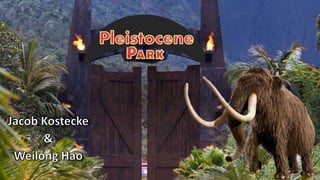
Genomics in Pleistocene Park: On the Internal Causes Driving Extinction
- 2. The Pleistocene Era • 2.5 million to 10,000 years ago • Last great ice age • Mega mammals • Woolly Mammoths & Rhinos • Giant Sloths & Bears • Saber Tooth Tigers
- 3. Knowledge Gap • The current research is insubstantial • Humans? • Climate Change? • Asteroid? • Genetic mutations? • Why Genetic Mutations? • More mutations can lead to extinction • Unique perspective
- 4. The Hypothesis “I hypothesize that accelerated genetic mutation plays a major role in the extinction of mega mammals during the Pleistocene era”
- 5. Aims 1 “Aim 1 will determine whether the extinct mammals have undergone accelerated evolution compared to their closest relatives” • If an extinct species were under accelerated evolution than all genomic region have high substitution rates. • Longer branches are a proxy for more mutation accumulation • Extinction branch should be shorter compared to living due to dying out earlier
- 6. ”Aim 2 will determine whether all extinct species suffered a prolonged small population size” Aims 2 High dN/dS ratio Low dN/dS ratio • Compare synonymous vs nonsynonymous substitutions between extinct and living species • Ratio = nonsynonymous over synonymous substitution rates (dN/dS ratio) • Higher dN/dS ratio indicates more relaxed selection • Determine how much accelerated evolution is cause by nonsynonymous substitution Population sizes
- 7. • 25 extinct mammal species • 13 coding genes each • BLAST to find 3 closest living relatives • Constructed Phylogenetic trees to see relationship • Alignment of extinct with 1st & 3rd living relatives (outgroup) • Mitochondrial Genomes are an Excellent Vessel • Abundant in preserved specimen • Well preserved & smaller size • Traceable mutation patterns easily interpreted The Methods
- 8. Results: Synonymous Substitutions • The Data • Greater substitutions in extinct lineages • Extinct lineages have different mutations patterns than living relatives • These are also supported in analyses on non-synonymous subs and in different functional complexes • Conclusion • Extinct underwent accelerated mutation accumulation before dying out * Check out the Data Tab to see the break down of mutations per genes
- 9. Results: dN/dS Ratio • dN/dS Ratio • The higher dN/dS ratio is consistent with more relaxed selection due to prolonged small population size * Check out the Data Tab to see the break down of ratios per genes • The Data • Extinct species had higher dN/dS Ratio of mutations than living • Extinct had more nonsynonymous mutations • Conclusion • Extinct species underwent accelerated evolution under a prolonged small population before dying out # non-syn # syn Ratio Extinct 1319 7267 0.182 Living 1128 6722 0.168 Chi-square P-Value 0.000
- 10. QUESTIONS? *Click the Meeting Room Button on the Right Side of the Page to Join Thank You!
Editor's Notes
- Aim 1 will determine whether the extinct mammals have undergone accelerated evolution compared to their close relatives. We will reconstruct ancestral sequences and quantify nucleotide changes in coding genes and non-coding regions in extinct species versus in their close relatives. With the known time of extinction, we will quantify the relative substitution rates in extinct species over their related living species. We expect to identify mitochondrial DNA regions under accelerated evolution. Aim 2 will determine whether all extinct species suffered a prolonged small population size. We will quantify nucleotide changes that do or don't lead to amino acid changes (synonymous, nonsynonymous substitutions) and compare synonymous versus nonsynonymous substitutions between extinct and living species. As nonsynonymous substitutions are more likely to get fixed in the small populations by chance, these analyses will address whether extinct species had a prolonged small population size [7]. The results will also determine how much accelerated evolution is caused by nonsynonymous substitution, i.e., driven by prolonged small population size.
- Aim 1 will determine whether the extinct mammals have undergone accelerated evolution compared to their close relatives. We will reconstruct ancestral sequences and quantify nucleotide changes in coding genes and non-coding regions in extinct species versus in their close relatives. With the known time of extinction, we will quantify the relative substitution rates in extinct species over their related living species. We expect to identify mitochondrial DNA regions under accelerated evolution. Aim 2 will determine whether all extinct species suffered a prolonged small population size. We will quantify nucleotide changes that do or don't lead to amino acid changes (synonymous, nonsynonymous substitutions) and compare synonymous versus nonsynonymous substitutions between extinct and living species. As nonsynonymous substitutions are more likely to get fixed in the small populations by chance, these analyses will address whether extinct species had a prolonged small population size [7]. The results will also determine how much accelerated evolution is caused by nonsynonymous substitution, i.e., driven by prolonged small population size.